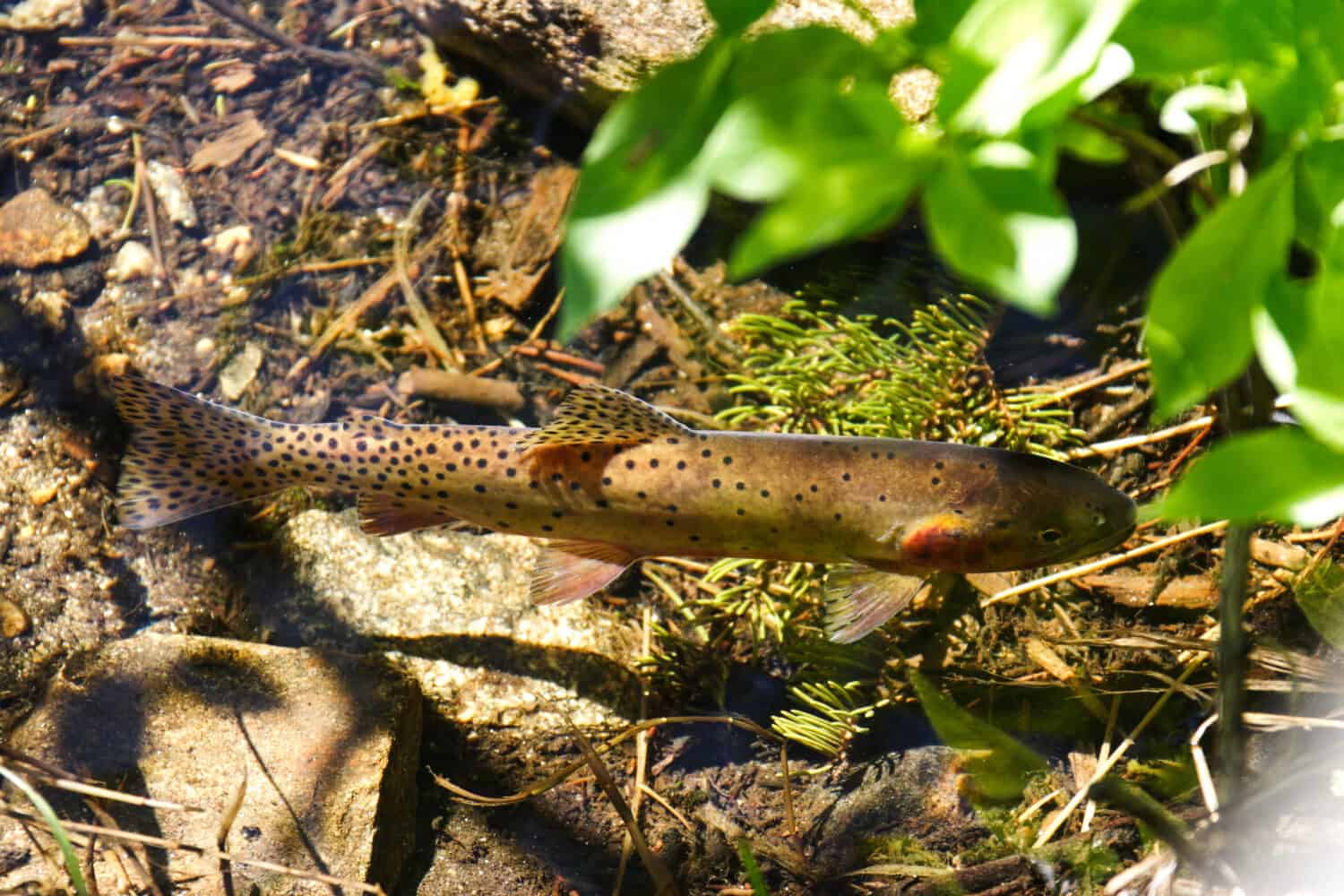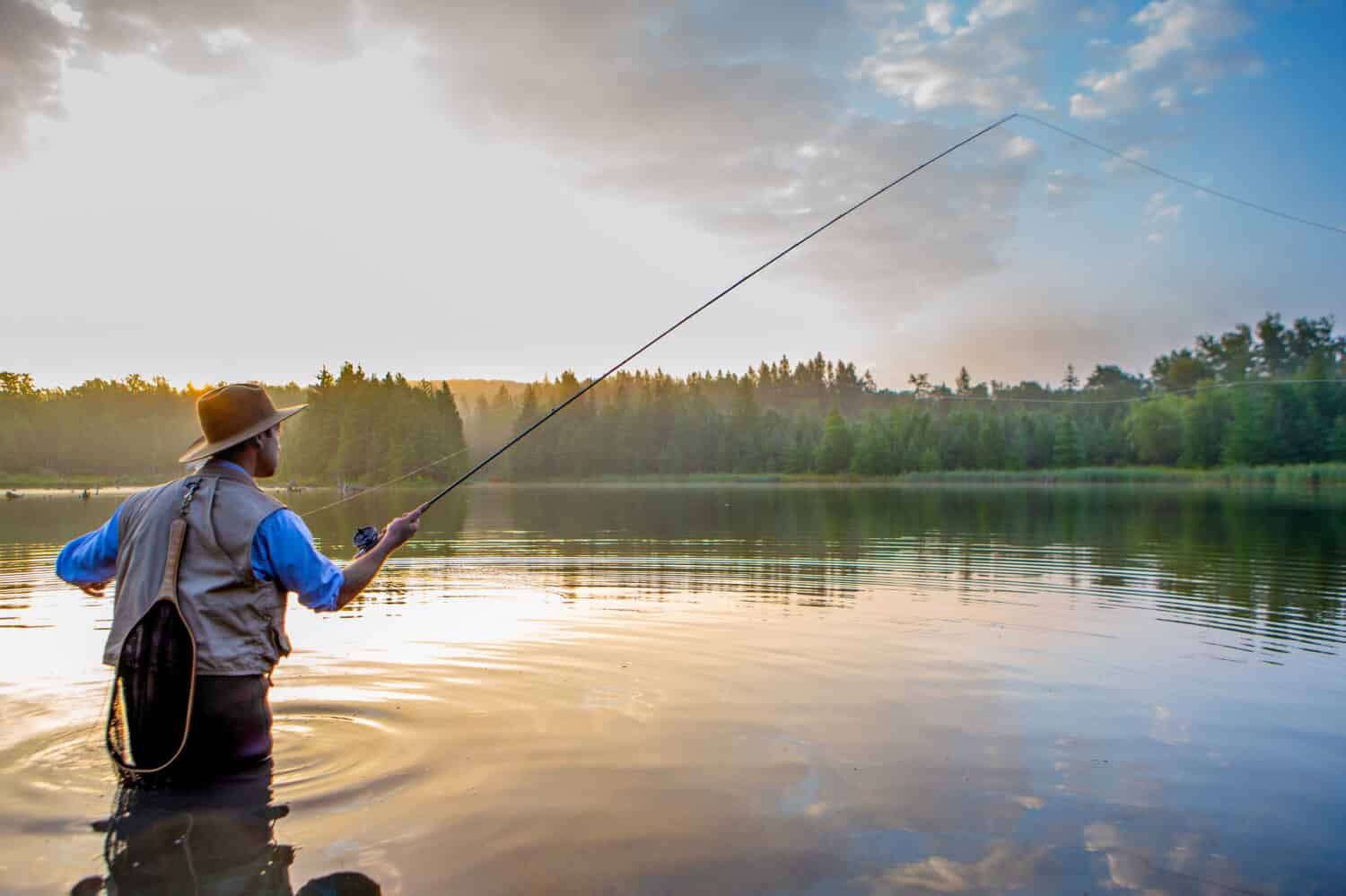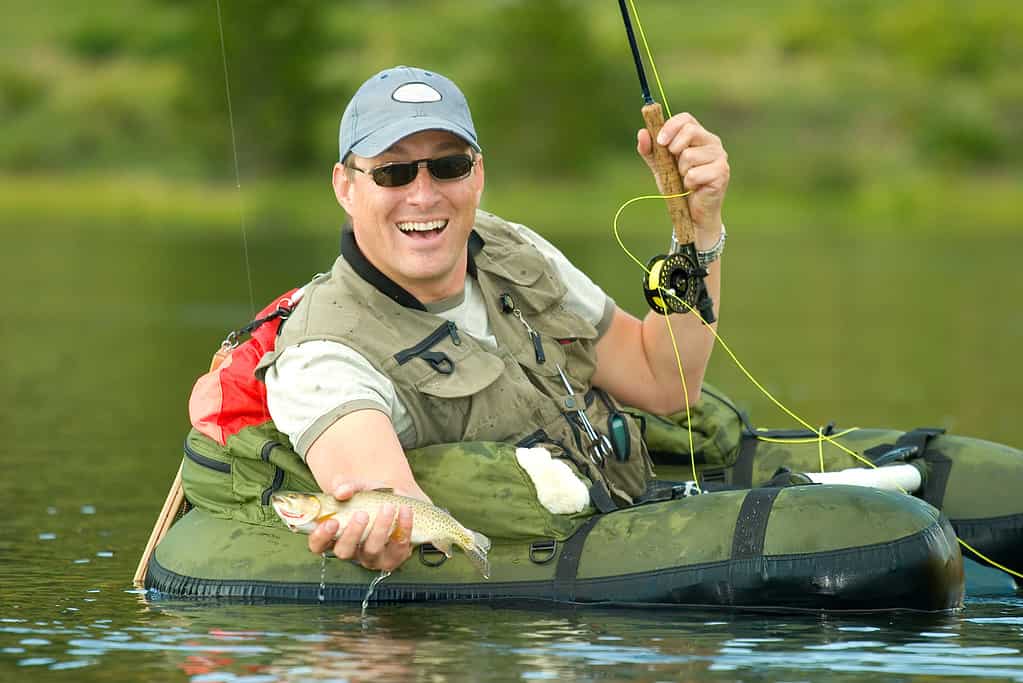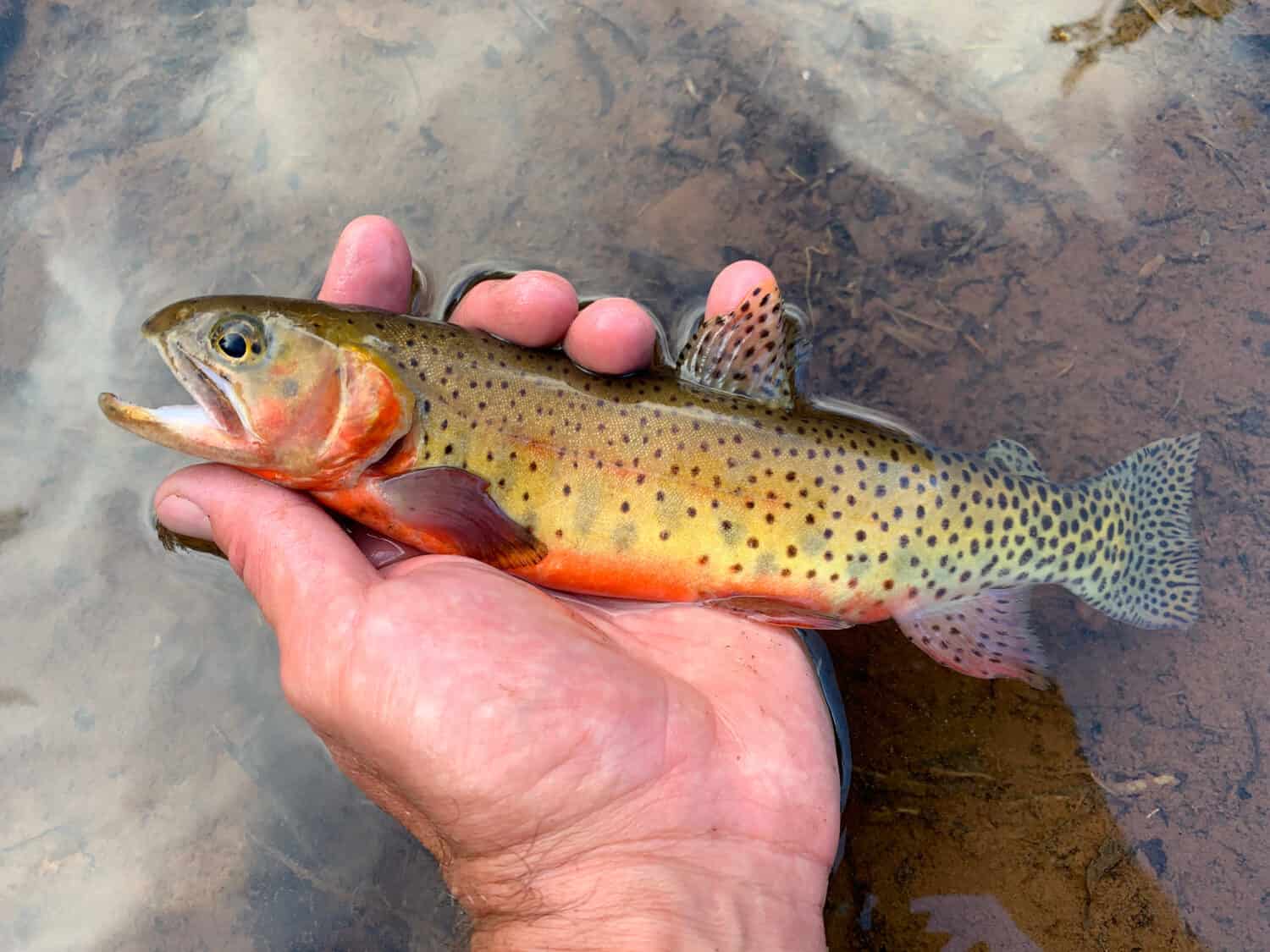Colorado is teeming with a wide variety of fish species. But what is the official state fish of Colorado, and where might you spot it during the summer?
Let’s find out!

The Official State Fish of Colorado
The official Colorado State fish is the greenback cutthroat trout. The captivating creature intertwines itself into the natural tapestry of the state. However, its presence in Colorado’s waters is less widespread than it once was.
The greenback cutthroat trout, a native of Colorado, has a story that’s as vibrant as its brilliant spawning coloration. After being thought extinct in the 1930s, this fish made a surprising comeback in the late 1950s when researchers discovered several populations in the South Platte and Arkansas basins. This discovery sparked a massive conservation effort, leading to the greenback cutthroat trout being named Colorado’s state fish in March 1994.
Their Complicated History
However, the story took an unexpected turn when scientists discovered that the true greenback cutthroat trout, originally from the South Platte basin, were only found in one stream outside their original home. This discovery led to even more efforts to help this population grow. In 2014, they began reintroducing more of these fish into the wild.
Scientific research has been crucial in understanding and protecting the greenback cutthroat trout. One study found that the greenback cutthroat trout and another type of trout, the Colorado River cutthroat trout and the Rio Grande cutthroat trout, are so similar that it’s hard to tell them apart. This cause could be because they haven’t been separate species for very long or because they’ve been mixing. Another study used old records and DNA from the 19th century to show how human actions have changed where different types of cutthroat trout live.
Despite the challenges they’ve faced, the greenback cutthroat trout continues to swim in Colorado’s waters. In 2022, Colorado Parks and Wildlife announced the discovery of the greenback cutthroat trout naturally reproducing in Herman Gulch. Their efforts are an example of the resilience of these fish and the success of conservation efforts despite the notable population decline from 2017 to 2020.

Greenback cutthroat trout were thought to be extinct in the 1930s, however, in the 1950s researchers discovered several populations in the South Platte and Arkansas basins.
©Gregory Simpson/Shutterstock.com
A Description of the Greenback Cutthroat Trout and Its Natural Habitat
This trout species is a member of the Salmonidae family and is scientifically known as Oncorhynchus clarkii stomias. It is the easternmost subspecies of cutthroat trout, Oncorhynchus clarkii. Its name, “Greenback,” is derived from the distinctive greenish hue found along its back and sides, which beautifully contrasts with the fish’s small, black spots and the red coloration underneath its jaw, a characteristic feature of mature individuals.
The greenback cutthroat trout is a medium-sized fish, typically reaching 12 to 18 inches long. However, some individuals have grown up to 20 inches. They can also weigh up to roughly 9.9 pounds. This fish can live up to five years old in smaller rivers and up to ten years old in lakes. The bodies of greenback cutthroat trout are elongated and slightly compressed. Their broad, square tails frequently bear black spots. Their back and upper sides are a vibrant green-to-olive coloration, transitioning to a lighter silver on their bellies. Finally, a distinctive pattern of small, rounded black spots adorns their sides, extending onto the dorsal, adipose, and caudal fins.
Their Natural Habitat
The natural habitat of the greenback cutthroat trout is as unique as the fish itself. Historically, the cool, clear waters of Eastern Colorado’s South Platte River drainages hosted these trout. They prefer high-altitude streams and rivers with gravel bottoms and an abundance of aquatic vegetation. They are opportunistic feeders, and these habitats provide the trout with ample cover and a rich diet of insects, small fish, and crustaceans.

Greenback cutthroat trout have been reintroduced into the wild and are now present in 52 locations with 19 stable populations across Colorado.
©PhotoTrippingAmerica/Shutterstock.com
How Common Is the Greenback Cutthroat Trout in Colorado?
While not as common as it once was, the greenback cutthroat trout remains a vital part of Colorado’s natural heritage. The ongoing efforts to conserve and restore this species are a testament to Colorado’s commitment to preserving its unique biodiversity. As these efforts continue, we hope that the greenback cutthroat trout will thrive again in Colorado waters. So far, efforts have been promising, and the distribution of this fish is expanding.
What Is the Estimated Population?
Once teeming in the Arkansas and South Platte River drainages of Eastern Colorado and Southeast Wyoming, the greenback cutthroat trout now occupies less than 1% of its historical range. The reasons for this decline are manifold, including habitat loss due to mining, logging, and the construction of railroads in the late 19th and early 20th centuries. Additionally, the introduction of non-native trout species into Colorado’s waters led to competition and hybridization, further threatening the greenback’s survival.
Scientific studies over the past 15 years have shed light on the current status of the greenback cutthroat trout in Colorado. In 2012, researchers discovered that the greenback cutthroat trout’s wild population existed solely in one place within Bear Creek, a small tributary of the Arkansas River. This population was estimated to consist of approximately 750 individuals at the time.

There are active conservation methods in place to help the greenback cutthroat trout thrive in Colorado again, including the removal of non-native species, habitat restoration, as well as breeding and stocking.
©Jennifer de Graaf/Shutterstock.com
Conservation Efforts to Protect the Greenback Cutthroat Trout
Despite the challenges faced by the greenback cutthroat trout, efforts have been underway to increase their population and distribution in Colorado to the present day. Conservation programs led by Colorado Parks and Wildlife and other organizations are working to restore greenback populations by improving their habitats and reintroducing them into their native range. These efforts include the removal of non-native species, habitat restoration, and the breeding and stocking of greenbacks from the Bear Creek population. With all the ups and downs, the future of this unique fish is looking brighter.
A Collaborative Effort
The conservation of the greenback cutthroat trout is a collaborative effort involving federal and state agencies, non-profit organizations, and local communities. The U.S. Fish and Wildlife Service (USFWS) and Colorado Parks and Wildlife (CPW) are at the forefront of these efforts, implementing a range of strategies to protect and restore the Greenback Cutthroat Trout populations.
One of the vital conservation strategies is habitat restoration. The greenback cutthroat trout thrives in cool, clear, high-altitude streams and rivers. As we previously discovered, human activities such as mining, logging, and water diversion for agriculture have significantly degraded these habitats. The USFWS and CPW have been working to restore and rehabilitate the trout’s natural habitats to address this. These efforts include improving water quality, restoring streamside vegetation, and stabilizing stream banks.
Another crucial aspect of greenback cutthroat trout conservation is managing non-native species. Non-native trout species introduced into Colorado’s waters have outcompeted the greenback cutthroat trout for resources and have hybridized with them, diluting the greenback’s gene pool. To combat this, conservationists have been removing non-native species from key habitats and implementing measures to prevent their reintroduction.
Breeding and Stocking Programs
The USFWS and CPW also operate captive breeding and stocking programs to boost the greenback cutthroat trout numbers. These programs collect eggs and milt from wild greenback cutthroat trout, utilizing them to produce young trout in a controlled environment. Once these trout reach a specific size, they are released back into suitable habitats. This strategy not only increases the greenback cutthroat trout population but also helps to maintain its genetic diversity.
Public education and outreach are also integral to greenback cutthroat trout conservation. Organizations like Colorado Trout Unlimited and The Nature Conservancy work to raise awareness about the Greenback Cutthroat Trout’s plight and the importance of its conservation. They organize volunteer events, educational programs, and fundraising campaigns to support conservation efforts.
Furthermore, conserving the greenback cutthroat trout is a multifaceted effort involving habitat restoration, non-native species management, captive breeding and stocking, and public education. While challenges remain, these efforts have already made a significant impact, helping to secure a future for this unique and important species.

You can fish for greenback cutthroat trout but must release them. However, always check the current regulations before embarking on a fishing trip.
©GROGL/Shutterstock.com
Where Can You Find Greenback Cutthroat Trout in Colorado?
As of 2023, the greenback cutthroat trout is present in 52 locations with 19 stable populations across Colorado.
Over the past few years, there have been efforts from the Colorado Parks and Wildlife to reintroduce this fish back into the wild. Specifically to the South Platte Basin and around South Park, Clear Creek near the Eisenhower Tunnel, and Fort Collins areas. In 2022 they also announced that more of their efforts were bearing fruit, and the greenback cutthroat trout was naturally reproducing in Herman Gulch. This occurrence is, however, still a stark contrast to the thousands of greenbacks that once swam freely in Colorado’s rivers and streams during their prime.

The greenback cutthroat trout, a beloved and fascinating native trout to Colorado, is the official state fish of Colorado.
©iStock.com/scottdharris
Can You Fish for Greenback Cutthroat Trout?
Fishing is a popular pastime in Colorado. The state’s rivers and lakes are teeming with a variety of fish species, including the greenback cutthroat trout. However, fishing for this particular species is subject to specific regulations due to its status as a threatened species.
In Colorado, fishing is regulated by the Colorado Parks and Wildlife. The CPW provides a comprehensive fishing brochure that outlines the regulations for fishing in the state. This includes those specific to the greenback cutthroat trout. These regulations cover everything from fishing seasons and bag limits to particular rules for different bodies of water.
Catch-And-Release
According to the CPW, they permit fishing for the greenback cutthroat trout. However, they have implemented specific regulations to protect this threatened species. For instance, certain bodies of water may be designated as catch-and-release areas for this species. This means that any greenback cutthroat trout caught must be immediately released back into the water.
Some locations for catch-and-release include the Rocky Mountain National Park, which consists of the North Fork Thompson River and numerous lakes. Another location is the San Isabel National Forest, specifically Lake Fork Creek and numerous other lakes. The Roosevelt National Forest is another location, particularly at Sheep Creek and Zimmerman Reservoir. And finally, Arapaho National Forest, in the Cornelius, George, and Bard creeks.
Regarding the fishing locations for greenback cutthroat trout in Colorado, you can find these fish in high-altitude streams and rivers. However, conservation efforts have expanded their range, enabling them to inhabit various bodies of water throughout the state. The CPW offers a list of waters where you can find this fish. However, it is always advisable to check the current regulations before embarking on a fishing trip.
Furthermore, while you are allowed to fish for the greenback cutthroat trout in Colorado, it’s essential to be aware of and adhere to the regulations in place to protect this unique and threatened species. By doing so, you can enjoy the thrill of fishing while also contributing to the conservation of Colorado’s natural heritage.

The Colorado River trout closely resembles the greenback cutthroat trout, but they are different subspecies of cutthroat trout.
©Sean Lema/Shutterstock.com
Conclusion
The greenback cutthroat trout is a symbol of Colorado’s rich natural heritage. It is a fascinating species that has demonstrated remarkable resilience in the face of adversity. This trout, known scientifically as Oncorhynchus clarkii stomias, is the easternmost subspecies of cutthroat trout. It captivates with its striking appearance, characterized by large spots and a vibrant color palette. The greenback cutthroat trout can grow up to 18 inches long and is known for its distinctive red throat. This is a common trait among cutthroat species. In the past, some specimens reached a weight of up to 9.9 pounds.
The greenback cutthroat trout’s preferred habitats are as distinctive as the fish itself. Originally, you could find these trout in the cool, clear waters of the South Platte River drainages in Eastern Colorado. However, human activities have significantly impacted their habitats. Mining operations led to water contamination. While agricultural water diversion and overfishing further contributed to the decline of greenback cutthroat trout populations.
The Greenback Cutthroat Trout is a Survivor
Yet, the greenback cutthroat trout has proven to be a survivor. Once considered extinct in the 1930s, people rediscovered several wild populations in the late 1950s. This discovery sparked a comprehensive conservation effort, successfully replicating these populations in various locations. As a result, the reclassification of the greenback cutthroat trout from endangered to threatened occurred under the Endangered Species Act. In 1994, it was officially recognized as Colorado’s state fish, underscoring its significance to the state.
The conservation of the greenback cutthroat trout is a team effort involving diverse stakeholders. Key players include the U.S. Fish and Wildlife Service and Colorado Parks and Wildlife. Who has been instrumental in implementing various strategies to protect and restore greenback cutthroat trout populations. These strategies encompass habitat restoration, management of non-native species, captive breeding and stocking programs, and public education initiatives.
In conclusion, the greenback cutthroat trout is a testament to the rich biodiversity of Colorado. As well as a symbol of resilience in the face of adversity. Despite its numerous challenges, this unique fish continues to endure, primarily due to the ongoing conservation efforts. As these efforts persist, there is hope that the greenback cutthroat trout will continue to flourish in Colorado’s waters.
Thank you for reading! Have some feedback for us? Contact the AZ Animals editorial team.







